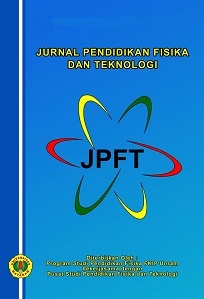Pengembangan Modul Elektronik Dengan Feedback Berbasis Android Materi Suhu Dan Kalor Untuk Siswa SMA/MA
DOI:
10.29303/jpft.v6i1.1731Published:
2020-03-19Issue:
Vol. 6 No. 1 (2020): Januari-JuniKeywords:
electronic module, android, feedbackArticles
Downloads
How to Cite
Downloads
Metrics
Abstract
The integration of ICT in the learning process has a positive effect on students' concepts understanding and learning interests. Android is a learning media tool that can store lots of interesting learning materials, such as electronic modules. This study was conducted to determine the feasibility of an Android-based electronic module with temperature and heat material feedback for high school / MA students. This research method is used in the ADDIE model (analysis, design, development, implementation, and evaluation). The electronic module was tested for validation by the validator with an average value of 3.49 and the module readability test with respondents of 85 students who obtained an average value of 79.3%. Based on the data obtained, it can be conclude that the electronic module has decent criteria.
References
Ali, M. (2009). Pengembangan media pembelajaran interaktif mata kuliah medan elektromagnetik. Jurnal Edukasi Elektro, 5(1).11-18.
Arianti, B. I., Sahidu, H., Harjono, A., & Gunawan, G. (2017). Pengaruh model direct instruction berbantuan simulasi virtual terhadap penguasaan konsep siswa. Jurnal Pendidikan Fisika dan Teknologi, 2(4), 159-163.
Arikunto. (2006). Prosedur Penelitian Suatu Pendekatan Praktek. Jakarta: PT. Rineka Cipta.
Arista, F. S., & Kuswanto, H. (2018). Virtual Physics Laboratory Application Based on the Android Smartphone to Improve Learning Independence and Conceptual Understanding. International Journal of Instruction, 11(1), 1-16.
Conde, Miguel ÃÂngel, and David Fonseca. (2018). Information Society Skills: Is Knowledge Accessible for All? Part I. Pp. 223ââ¬â27 in Universal Access in the Information Society. Vol. 17.
Fathoni, M. I., & Marpanaji, E. (2018). Pengembangan e-book interaktif mata pelajaran teknologi informasi dan komunikasi (TIK) untuk SMK kelas X. Jurnal Inovasi Teknologi Pendidikan, 5(1), 70-81.
Ghaliyah, S., Bakri, F., & Siswoyo, S. (2015). Pengembangan modul elektronik berbasis model learning cycle 7E pada pokok bahasan fluida dinamik untuk siswa SMA kelas XI. In Prosiding Seminar Nasional Fisika (E-Journal) (Vol. 4, pp. SNF2015-II).
Herawati, N. T. (2017). The Implementation of Self-Regulated Learning Model Using ICT Media Toward the Students Achievement in Introduction to Accounting Course. Journal of Accounting and Business Education, 2(1), 144-157.
Herayanti, L., Gummah, S., Sukroyanti, B. A., Gunawan, G., & Makhrus, M. (2018). Pengembangan Perangkat Pembelajaran Berbasis Masalah Meggunakan Media Moodle Untuk Meningkatkan Keterampilan Berpikir Kritis Mahasiswa Pada Materi Gelombang. Jurnal Pendidikan Fisika dan Teknologi, 4(2), 158-167.
Hörisch, J., Wulfsberg, I., & Schaltegger, S. (2019). The Influence of Feedback and Awareness of Consequences on the Development of Corporate Sustainability Action Over Time. Business Strategy and the Environment. (August):1ââ¬â13.
Mardiana, N., & Kuswanto, H. (2017). Android-assisted Physics Mobile Learning to Improve Senior High School Studentsââ¬â¢ Divergent Thinking Skills and Physics HOTS. In AIP Conference Proceedings (Vol. 1868, No. 1, p. 070005). AIP Publishing LLC. (August)
Mariki, B. E. (2013). Use of ICT in Distance Education at Hanyang Cyber University: Possible Best Practices for The Institute of Adult Education. Turkish Online Journal of Distance Education, 14(2), 185-195.
Mihaela, Paisi LÃŽzÃŽrescu, & Stan Maria Magdalena. 2017. ââ¬ÅStudent Centered Learning Using ICT.ââ¬Â Pp. 1ââ¬â4 in Proceedings of the 9th International Conference on Electronics, Computers and Artificial Intelligence, ECAI 2017.
Rahayu, P., Prastowo, S. H. B., & Harijanto, A. (2018). Indentifikasi Pemahaman Konsep Fisika Pokok Bahasan Suhu Dan Kalor Melalui Three Tier Test Pada Siswa Sma Kelas XI. FKIP e-PROCEEDING, 3(1), 226-230.
Rahman, H. (2014). The role of ICT in open and distance education. Turkish Online Journal of Distance Education, 15(4), 162-169.
Sahidu, H., Gunawan, G., Indriaturrahmi, I., & Astutik, F. (2017). Desain Sistem E-Assessment pada Pembelajaran Fisika di LPTK. Jurnal Pendidikan Fisika dan Teknologi, 3(2), 265-270.
Sugiana, I. N., Harjono, A., Sahidu, H., & Gunawan, G. (2017). Pengaruh Model Pembelajaran Generatif Berbantuan Media Laboratorium Virtual Terhadap Penguasaan Konsep Fisika Siswa pada Materi Momentum dan Impuls. Jurnal Pendidikan Fisika dan Teknologi, 2(2), 61-65.
Sugiono. (2015). Metode Penelitian Pendidikan. Bandung: Alfabeta.
Widyawati, A., & Prodjosantoso, A. K. (2015). Pengembangan media komik IPA untuk meningkatkan motivasi belajar dan karakter peserta didik SMP. Jurnal Inovasi Pendidikan IPA, 1(1), 24-35.
Yoon, Hyeon-Ju. (2012). A Study on the Performance of a Gyromonotron. International Journal of Infrared and Millimeter Waves, 4(4):437ââ¬â52.
Yot-DomÃÂnguez, Carmen, and Carlos Marcelo. (2017). University Studentsââ¬â¢ Self-Regulated Learning Using Digital Technologies. International Journal of Educational Technology in Higher Education, 14(1).
Yulianci, S., Gunawan, G., & Doyan, A. (2017). Model Inkuiri Terbimbing Berbantuan Multimedia Interaktif Untuk Meningkatkan Penguasaan Konsep Fisika Peserta Didik. Jurnal Pendidikan Fisika dan Teknologi, 3(2), 146-154.
Author Biographies
Amaliyah Tazkiyah, Universitas Negeri Malang
Sulur Sulur, Universitas Negeri Malang
Sahal Fawaiz, Universitas Negeri Malang
License
Authors who publish with Jurnal Pendidikan Fisika dan Teknologi (JPFT) agree to the following terms:
- Authors retain copyright and grant the journal right of first publication with the work simultaneously licensed under a Creative Commons Attribution License 4.0 International License (CC-BY-SA License). This license allows authors to use all articles, data sets, graphics, and appendices in data mining applications, search engines, web sites, blogs, and other platforms by providing an appropriate reference. The journal allows the author(s) to hold the copyright without restrictions and will retain publishing rights without restrictions.
- Authors are able to enter into separate, additional contractual arrangements for the non-exclusive distribution of the journal's published version of the work (e.g., post it to an institutional repository or publish it in a book), with an acknowledgement of its initial publication in Jurnal Pendidikan Fisika dan Teknologi (JPFT).
- Authors are permitted and encouraged to post their work online (e.g., in institutional repositories or on their website) prior to and during the submission process, as it can lead to productive exchanges, as well as earlier and greater citation of published work (See The Effect of Open Access).











